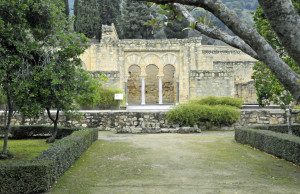In 929 A.D., Abd-ar-Rahman III declared himself Caliph of Cordoba. Seeking to demonstrate that he was equal to his title, in 936 Rahman began building a magnificent new palace city on a 300-acre site in the foothills of the Sierra Morena a few miles west of Cordoba. The architects took advantage of the hill-side by designing three terraces, the top reserved for the palace and the bottom for government workers. The middle terrace included a hall for receiving foreign ambassadors, covered with ivory and gold to impress the visitors. The hall also reportedly included a bowl of mercury the Caliph could jiggle to scatter reflected sunlight around the room.
When completed in about 976, Medina Azahara incorporated more than 4,000 marble columns, some scavenged from as far away as Carthage. Most of the columns supported horseshoe arches, an architectural feature borrowed from the Visigoths but modified by alternating stones of different colors to call attention to the curved shape. Some of the arched columns separated courtyards from surrounding areas, a novel idea at the time. Formal Islamic gardens, watered by an aqueduct from the mountains, bordered the most important buildings. A modified Roman aqueduct served as a sewer. At the end of the tenth century, when Cordoba was the intellectual center of Europe, no city in the world could match the splendor of Medina Azahara.
In 1010, Berber forces battling for control of Cordoba destroyed Medina Azahara. The city was abandoned and many of the columns and arches were carried away and reused. Medina Azahara itself was soon buried and forgotten, but its architectural ideas, including the column-encircled courtyard and horseshoe arches, found their ways into buildings throughout southern Spain and eventually influenced the design of the Alhambra. Archaeologists who began excavating at Medina Azahara in 1911 have uncovered about 10 percent of the original city, including the palace and reception hall. The so-called “Versailles of the Middle Ages” is forgotten no more.
